#cli analysis
Explore tagged Tumblr posts
Text
Gooooood morning Trigun fandom, I'm up bright and early, ready to sink my teeth into today's analysis/detailed watchthrough episode - 11. To A New World.
I can't believe we're almost done with @tristampparty. These 12 days have been a blast and I'm very glad that I got to chat abt them!! I've been in a bout of artblock recently too, so I'm glad that I can just ramble instead!
Spoilers for Trigun Stampede and Trigun Maximum, and CWs for. okay this one is a Lot, but discussion of violation of bodily autonomy, sexual assault and trauma, pregnancy, transphobia, harm coming to children, Millions Knives in general, Vash's passive suicidal tendencies. If I think of any more I'll pop them up here but this episode is a heavy one!
If you wanna skip those first few CWs (Totally understandable <3), you can skip the paragraphs labelled with a [CW] at the front.
[CW] Okay so we're gonna tail off the end of Episode 10 for a second, but uh. Knives in this scene is using extremely Loaded Language to outright tell Vash that there is something wrong with him that needs to be fixed.
Just to be clear I do think Vash is very trans-coded (intentionally or not), and that very strongly influences how I interpret this scene - I myself am a trans man as well.
Cool, moving on! That's all really for the end of ep 10, I just needed to point out that Knives is using language that is commonly used to justify corrective sexual assault; which is pretty much what my reading of this scene is analogous to.

what in the fresh hell i got jumpscared by dub again. returning to subs hold on a moment. Like i've been checking dub occasionally to match up some dialogue and make sure I'm not being misled by Subtitle Jank but I'm one of those guys who can't listen to anything without subtitles lmao
But i also think i do get the funniest possible translation of this line - actually wait no i hate the double meaning (with Vash's body being used to kickstart the pregnancy imagery). was that intentional. who did this.

Anyway Meryl kicking Wolfwood is really funny but also like. Yeah. justified. She's having a no good awful time but like. She's so willing to believe in Vash, to chase after him even into Extremely Dangerous conditions (There's those hints of Trimax Meryl again....) and Wolfwood is being an ass here. (An understandable ass. But an ass nonetheless). Which is to say YEAHHH MERYL GET HIS ASS!!!

Knives' gay little like. bodysuit here. He and Vash have the same build but their respective clothes make them stand out very differently. Also that Knives' stuff seems to have more muscle definition (HYDRATE. You shouldn't have that Knives you need water :pensive:) which could be building towards his more intimidating appearance.
Also I'd be a fool to not show everyone my initial reaction to this


I've talked a little bit about how Vash uses his gun as a tonfa (thwacky baton) most of the time in melee combat, and I think that's a great way to show him utilizing something Knives gave him to Kill as a nonlethal weapon - in this, however, he doesn't have it and his normally very fluid very good form martial arts is flailing and panicked. Vash is pretty good at keeping his cool in most combat situations, and is a very skilled fighter. Seeing him lose that cool and just start struggling when Knives tries to grab him is :(

Once again the metal/organic dichotomy is coming into play - the creation of inorganic but the destruction that comes from the organic. Typically plant (as in flora) powers in media lend themselves to being creation powers, life, and healing. But Vash here has that plant (flora) theme but those are very much a force for destruction.
Also Knives with the angelic white, and Vash with the black.

I hate Conrad So Much (he's such a good character). Like we Know to some extent that dependent plants are self-aware enough to feel pain, to hold onto memories, to hatred, to love. They don't have consciousness the same way humans or Independents do, but they feel, they live, they understand what Vash tells them. Maybe it is a shallow form of themselves. But I think something a lot of people fail to realize is that (some, not all, because they are individuals even throughout a hivemind) plants appear to enjoy their purpose.
Once again the memory that is shared with Knives in Trimax of a woman and her child thanking the plant for her service and she smiles? After being fused, that plant held onto that memory. I've been given no reason to believe that plants in Tristamp are different, so Conrad is just,,, ignoring the subtleties of plants and taking away their agency to choose for themselves. Doubly so for Knives, who can communicate efficiently with them.

A very quick blink and you'll miss it detail is that Vash says "It was our fault humans crashed here!". The shifting blame and guilt between the two is something that is fighting the narrative allll the time, but Vash attributing to both of them as an appeal to Knives is interesting to relay how he feels.
I also don't think Vash is right, though, when he says the only reason humans abuse plants is because they crashed. Tesla was before, Chronica in Trimax has apparently seen independent fusions before (For what reason?). Like yeah to this extent it's a result of the big fall, but there'd still be problems without it. Nobody is right in this argument lmao
(except me. I'm always correct about everything ever)

[CW] Once again - violating Vash's consent and autonomy because he does not agree with or differs from Knives. Corrective violation, in this case. It's also important that it's Meryl who calls this out - she has to really really struggle for her autonomy to be important. She's small, carry-able, inexperienced, doesn't have any special powers or genetic modification. She's carrying a tiny gun from a man who can never back her up anymore. In fact, nobody is backing her up! She's out here alone! But she's sticking up for Vash. She cares about him,,,, so much


SURPRISE ROBERTO ATTACK [sobs]
Meryl pulled the nail out of him and placed his hands gently over the wound, as one might do in a casket. A memorial of cigarettes and his flask. All this will be destroyed soon, but Meryl did give him a funeral to the best of her ability.

Knives using Roberto's image is cruel as hell. Not to Vash but to ME. He's already dead you can't do this to meeee. "How do you think they'll react when they learn you caused the big fall" He will never learn it!! he never got the chance!!!

So fun fact you can actually eat geraniums. It's just that if Rem had said yes Vash probably would have eaten it right there and then. I've made that mistake before (told one of my class that nasturtiums were edible and he just ate one. right from the plant)


So; the Tesla scene. Something I do want to point out is that Rem finds them almost immediately, and Knives doesn't immediately pass out - Is he still catatonic enough to miss Rem's speech, or did he hear it? Because the reason that Vash turned out like he did is because he was awake to go through that with Rem - Knives was unconscious the entire time and didn't get to start that trauma recovery.

It's also important to recognize that these memories could be unreliable, especially as Knives tampers with them later.
I do want to know which version of the Bible Knives was reading. Because depending on translation/version, you can get Very different ideas out of that.

Anyway Knives is kind of beginning his spiral in that memory - "Humanity never learns" kinda shit, which seems to take place after Tesla. Who knows how long. But baby Vash calls that out and goes "yeah lets have faith"! Baby Knives looks a tad shocked and then Present Knives just. Cuts off the memory. What was the ensuing conversation!!! Hello???




Like he's clearly Having Thoughts (The Horror), we just don't get to know what those were.
So remember when I said it was interesting that Vash said it was "our" fault that the ships crashed, sharing the blame?
Yeah that gave Knives some ammo that just. Broke him. Shifts it allllll to Vash. Update Vash's description to running on 18 guilt complexes, CPTSD, and bisexuality.

[CW] There's so many different forms of assault, metaphorical and. Not. That is happening in this scene from mind violation to Knives literally using Vash's (specifically Vash's) body as a vessel to impregnate other plants which. Hey did you know that pregnancy is a massive fear of a lot of trans men. So many transphobes reduce trans men to their capability to have children, as if that's all they're good for (even if it would kill them.), and that often leads to corrective rape in order to "remind them of biological reality". In this case, Vash is a plant, he's meant to create, and yet he doesn't. But he's still being used to create anyway.
Again, Meryl also directly calls out Vash's lack of consent and gets shot down by Conrad. The whole scene is just. Hgnrhgnhrhnrnrn. It's So,,, everything to me, because it's a really good scene and shows you how far gone Knives is in Tristamp.
There are panels in Trimax that are,,, the imagery is there, but it's very overt in Tristamp.

Also hey yeah. Why is Conrad still alive?? Did he have access to cold sleep? or it's probably the robotics but did he not think of enhancing humans that way? It might just be a temporary solution, I guess, given that he is. Actively coughing up blood.

Alright! I have finished this part of the analysis that I always Feel Strongly about lmao - I have fun doing it but that's such an emotionally heavy episode.
69 notes
·
View notes
Text
y...yippee..... <- just finished trimax
#cli speaks#i will be able to go to fandom now!!! i can do shit!!!#im fucking insaneeee#y'all might get my insane unhinged analysis ramblings too#jesus CHRIST
3 notes
·
View notes
Text
The CLI-ECA Regulations ensure that municipalities and developers account for conservation and environmental regulations during the planning and execution phases.
#CLI-ECA Regulation#CLI-ECA Regulations#stormwater management#sewer inspection#wastewater management#flow monitoring#municipal wastewater system#wastewater resource management#sewer flooding#waste water flow monitoring#sewer capacity analysis#wastewater
0 notes
Text
Part 2 of a Computer Science student's analysis of the FNAF: SB intro
Full with tech lingo, abundant personal interpretations, and translations so that my tech illiterate fellas may undertand whatever the fuck im yapping about!
This post is written under the context that you've read my last analysis. I highly recommend you first check out these two posts before continuing with this one if you haven't already: > First post + Continuation ( IMPORTANT!! ) > An addition to the first post
Once you've read through those two (three?) posts, come back here! You're back? You've read them? Awesome! Let's begin then. =)
Reminder! This analysis has been done based off of my own understanding of the subject of both computing and programming - which I am currently studying. I would also like to yet again shout out this reddit post, that also gives a great perspective. Definitely check it out if you're interested later!
Also I have not re-read this, you may find typos - don't hold it against me, they will be fixed, someday =(
Now then, fellas, this is where shit gets wild.
Last post, I talked about the command box we can see at the top right corner of the intro - what each command did and how it basically corresponded to what happens to freddy in the events of the intro.
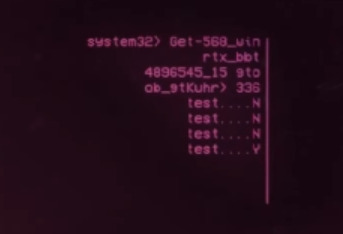
However, you might recall I mentioned a second command box, the one found at the left side of the screen. This command box is by far the most important piece of information we have throughout the entire duration of the intro. Mostly, because it changes 3 times.
It changes a total of 3 times in the time it takes for the right command box to finish.
Each time it changes, it displays new lines of code. And every single line of code it displays, tells us a lot about what is happening to Freddy.
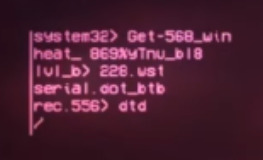
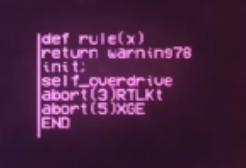
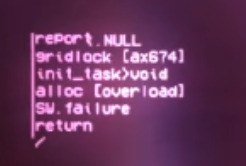
This is the first block of code that we get:
system32> Get-568_win heat_869%yTnu_bl8 lvl_b> 228.wst serial.dot_btb rec.556> dtd /
You might inmediately realize that the first line of code from this command box matches exactly the one from the first analysis. Here are both of them as comparison.
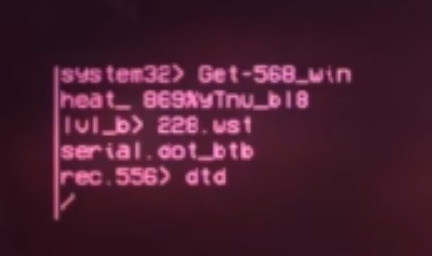
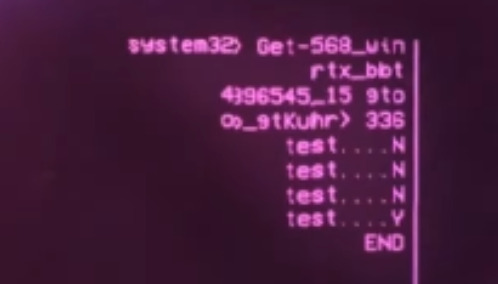
Hopefully, you've already made the connection. This command box is the one possibly being run by the Glitchtrap/Vanny Virus. Whatever lines of code appear on the command box to the left, are the ones being executed by the Virus - and they affect Freddy in real time. However, the command box on the right ir Freddy's, so to speak.
Both CLI (command line interfaces) are being run at the same time - yet independently of one another. Keep this in mind.
I don't want to go too in depth with this first block of code. All you need to know is that it moves around some directories and runs something called 'dtd', wich could be a command or a program.
The next two blocks of code, however? Ohhh damn... This is it, fellas. This is what I've been waiting for.
Now, I want you to know that this doesn't quite resemble any 'real' code, at least not at first glance. I do believe that it is a very 'condensed' form of the Python programming language, since the syntaxing of the commands shown here somewhat resemble how a string written in Python would look like.
So, I have taken the time to try to decipher what each line means, and what they do. And well, let's just say it explains why Freddy wasn't affected by the Virus in the first place.
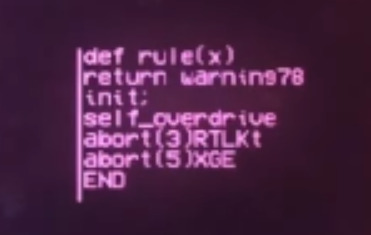
def rule(x) return warning78 init; self_overdrive abort(3)RTLKt abort(5)XGE END
This is the second block of code that we're shown, so lets break it down.
def rule(x) return warning78 init;
This string would define "rule" as a function, specifying "x" as the parameter. Basically, this line specifies that if the command rule is inputted, it should return whatever value (or argument) x has taken.
Normally, define is followed by a return function, which is why I've shown them together, as well as the init; command.
The command return followed by "warning78", makes it so whenever we call upon the function rule, it shows us whatever warning78 may be - and judging as to what happens in the intro, it could be any of the multiple warnings that appear in Freddy's GUI. Or it could also easily be the big "WARNING!" message that can be seen the entire time near the top of the screen.
Lastly, the init; command isn't exactly a standardized python command - but it is a common abreviation of the initialization command, where in the field of programming, it means "the assignment of an initial value for a data object or variable". Basically, it's when you assign the initial values and variables to a program so it can start.
All in all, these three lines create a command that, when called upon, gives out the warning78.
self_overdrive
Again, not really a python function, but important nontheless. This command doesn't have a specific meaning, but we can try to understand what it does.
The term overdrive doesn't really exist in the field of computing/programming. However, it is asociated with overclocking - "the practice of increasing the clock rate of a computer to exceed that certified by the manufacturer" - Overdrive is also a term in the field of music, also known as distorsion, which is when you force an amplifier to output past its limits.
Both of these definitions go around the same concept, pushing a computer to its limits so that it works better, or faster - even while it possibly damages the computer.
We can then assume that the function self_overdrive is making Freddy's system run pasts its usual limits. Which is why I believe Freddy's integrity level plumits during the intro.

abort(3)RTLKt abort(5)XGE END
Lastly, we have these three lines.
The abort function isn't a real python function - but I believe you can asume what it does. Both lines are attempting to kill something - a program, a process, another function... However, I am not sure wether these two are really functions, since they could very easily be error handling messages. Essencially, warning messages that the system returns when something crashes, for example.
The last line, END, specifies the end of this string of code.
Which leads us to the third and last block of code. The one which in my professional opinion, is the one that reveals to us why Freddy's cool with us during Security Breach! =]
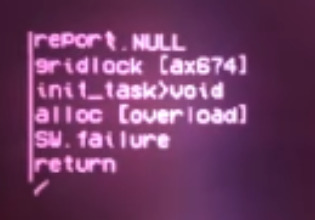
report.NULL gridlock [ax674] init_task>void alloc [overload] SW.failure return /
THIS IS WHAT WE'VE BEEN WAITING FOR, FRIENDS. THIS IS IT. This is the part where I had the most fun with this analysis...
report.NULL
Now, usually report, in the field of programming and software, it means to record or log something. For example an error log, or crash log. However, it being followed by NULL could also mean that this is an error handling message of sorts.
In computing, Null is, well, zero. It's nothing. It's the absence of value, when something that should be there, isn't.
From this, we could gather that this is a warning message that attempted to report something, yet failed to find anything to report back. No value at all.
...or, we could take this line literally. Taking into consideration that this code is being executed by the virus - this line of code could be taken as an attempt by the virus to stop Freddy's system from freaking out.
Remember that this entire code is being executed as Freddy's actively getting a big flashing WARNING! message. So, this line of code could be an effort to silence it, returning a null value to a warning message.
Both scenarios are plausible, so stick with the one you think fits best!
gridlock [ax674]
This one... man... this line was wild. It's where everything clicked for me. You will want to ignore the characters [ax674], what we truly care about is the first word: gridlock.
You see, a gridlock isn't really a term used in computing at all. It is a term refering to a "severe congestion of traffic, where continuous queues of vehicles block an entire intersection". HOWEVER, gridlock is also known as another term for deadlock.
A deadlock is what's known as a stalemate. A situation where two opposing parties come to a point where no progress can be made. In programming, it means basically the same thing.
A situation where two processes can't proceed, since both of them are waiting for the other to release a resource. Now, imagine this scenario. We have two processes, A and B, and two resources, R1 and R2.
Process A is currently using resource R1.
Process B is currently using resource R2.
Process A requests resource R2, but is blocked because it's held by Process B.
Process B requests resource R1, but is blocked because it's held by Process A.
Now... imagine this situation, but with Freddy, and the virus.
What we most likely have here, the line gridlock [ax674], is an error handling message, warning that a deadlock is ocurring. The string of characters beside it has no meaning, and could easily be but an error handling code of sorts.
init_task>void
I've explained before that init is the abreviation of initialization. So, we can gather that this is a command that is attempting to initialize a task. Now then, in the context of the previous line, this one could mean one of two things:
The virus is attempting to initialize a task (a set of instructions) called void.
The virus is attempting to initialize a task, however, due to the deadlock, it returns this line as an error message, indicating a void return. In programming, when a function returns the word void, it usually means that the function was not able to return a value. It is similar to Null, yet not the same.
Either of these could be a posibility, so I will leave it to your personal interpretation.
And here it when it all goes to hell...
alloc [overload] SW.failure return
Alloc is not a real function, but it can be considered an abreviation of the word allocation. In computing, the allocation is the assignment of memory and resources to the various processes the system may have.
Proper memory and resource allocation is very important in a computer. As you may know, a computer as a limited amount of RAM it can work with, and the same goes for it's processing power. But, for example, what happens when you try to allocate resources that aren't available?
Well, a lot of things may happen. Mainly, the program could hang, the process could freeze - or the entire system could crash!
Remember earlier, we saw that it was likely that Freddy and the virus were in a deadlock. Yet, the Virus tried to allocate more resources to itself... Which overloaded the system, and likely resulted in the next line.
SW.failure has no real meaning - but I've interpreted the first two characters [SW] as software. This would make this line an error message warning about a software failure.
So... What does this all mean? How does it all tie together? Why didn't Freddy get infected by the Virus? Because it got too greedy. It tried to allocate too many resources/memory, overloaded the system and crashed both itself and Freddy.

Why only Freddy, though? Why didn't this happen to the other animatronics? That... I'm not sure. I believe this is more of a lore question rather than computer question.
In my opinion, I don't think this was a case of 'Freddy knew that he was getting infected by a virus, and fought back'. I'm leaning more to the posibility of it being a 'wrong place wrong time' type of situation... or maybe 'right place right time'? In general, a lot of factors and a lot of different things happened that lead to this specific scenario happening.
Anyways, this is it! This has been my analysis - or nerdy infodumping, if you please.
I do hope that I was able to teach you something today, and that this whole analysis helps you understand the animatronics a bit better - and helps you with future fanfics, comics, AUs, artworks... whatever!
One last reminder - if you have any more questions about this stuff, my ask box is open! I love talking about this stuff!!
Oh, and, coming soon...
DJMM's Bouncer Mode ! A theory by a computer science student as to why it's still present, and why it makes him so aggressive.

#oh god is this post too long?#i hope this doesn't crash anyones phone im so sorry#anyways yea. DJMM bouncer mode explained coming soon#not me being a computer nerd AGAIN?#fnaf#fnaf sb#fnaf security breach#five nights at freddy's#security breach#snailsnarks#fnaf djmm#fnaf dj music man
96 notes
·
View notes
Text
Excerpt from this story from Heated:
Climate change is the greatest story of our time — but our time doesn’t seem to invent many great stories about climate change. Maybe it’s due to the enormity and urgency of the subject matter: Climate is “important,” and therefore conscripted to the humorless realms of journalism and documentary. Or maybe it’s because of a misunderstanding on the part of producers and storytellers, rooted in an outdated belief that climate change still needs to be explained to an audience, when in reality they don’t need convincing. Maybe there’s just not a great way to have a character mention climate change and not have it feel super cringe.
Whatever the reason, between 2016 and 2020, less than 3% of film and TV scripts used climate-related keywords during their runtime, according to an analysis by media researchers at the University of Southern California. (The situation isn’t as bad in literature, where cli-fi has been going strong since at least 2013.) At least on the surface, this on-screen avoidance of climate change continued in 2024. One of the biggest movies of the summer, Twisters, had an extreme weather angle sitting right there, but its director, Lee Isaac Chung, went out of his way to ensure the film didn’t have a climate change “message.”
I have a slightly different take on the situation, though — that 2024 was actuallyfull of climate movies, and, I’d argue, that they’re getting much closer to the kinds of stories a climate-concerned individual should want on screen.
That’s because for the most part, when movies and TV shows have tackled the topic of climate change in the past, it’s been with the sort of “simplistic anger-stoking and pathos-wringing” that The New Yorker’s Richard Brody identified in 2022’s Don’t Look Up, the Adam McKay satire that became the primary touchpoint for scripted climate stories. At least it was kind of funny: More overt climate stories like last year’s Foe, starring Saoirse Ronan and Paul Mescal, and Extrapolations, the Apple TV+ show in which Meryl Streep voices a whale, are so self-righteous as to be unwatchable (not to mention, no fun).
But what if we widened our lens and weren’t so prescriptive? Then maybe Furiosa, this spring’s Mad Max prequel, becomes a climate change movie. The film is set during a “near future” ecological collapse, and it certainly makes you think about water scarcity and our overreliance on a finite extracted resource — but it also makes you think about how badass the Octoboss’ kite is. The same goes for Dune: Part Two, which made over $82 million in its opening weekend and is also a recognizable environmental allegory featuring some cool worms. Even Ghostbusters: Frozen Empire, a flop that most people have already memory-holed, revisitedThe Day After Tomorrow’s question of, “What if New York City got really, really, really cold?”
11 notes
·
View notes
Text
Turning Panic Into Action: Astraweb’s Client Centered Process

When Jane Doe first reached out to Astraweb, she was overwhelmed with panic and uncertainty. Her life savings, heavily invested in cryptocurrency, had abruptly disappeared following a severe market crash. What initially felt like an irreversible loss soon transformed into a hopeful journey toward recovery all thanks to Astraweb’s dedicated, client-centered process.
The First Contact: Providing Calm, Reassurance, and Genuine Understanding
The difference began immediately at the first point of contact. Many companies in the digital asset recovery space treat clients as case numbers rather than individuals, but Astraweb prides itself on a profoundly human approach. From the moment Jane connected with their team, she was met with calm professionalism and empathetic understanding. Astraweb’s experts didn’t just collect the basic facts of her situation; they invested time in learning about her unique concerns, fears, and goals.
This personalized attention is critical. Financial loss, especially in the volatile cryptocurrency market, is not just about money it’s deeply tied to emotional well-being and future security. By acknowledging Jane’s distress and validating her fears, Astraweb’s team immediately alleviated much of her initial panic. They reassured her that despite the challenging circumstances, recovery was possible and that Astraweb would support her every step of the way. This empathetic approach planted the seeds of hope and trust that would sustain Jane through the recovery process.
Transparency and Clear Communication: Building Trust Through Every Step
One of the cornerstones of Astraweb’s client-centered methodology is transparency. Jane was kept fully informed from the outset, with the team providing clear, jargon-free explanations of the entire recovery process. Rather than leaving her uncertain or confused, Astraweb made sure she understood each step, from preliminary case assessment to the complex asset tracing and retrieval efforts ahead.
Regular, timely updates ensured that Jane never felt left in the dark. She received progress reports outlining milestones achieved, any obstacles encountered, and the strategies planned moving forward. This ongoing dialogue was more than just information sharing it was a partnership. Jane had the opportunity to ask questions, raise concerns, and engage actively in decision-making. Astraweb’s responsiveness and clarity gave her a sense of control and confidence, which is often lacking when facing financial recovery situations

Strategic Action and Efficient Recovery: Delivering Results with Precision and Care
With a thorough plan in place, Astraweb’s team mobilized swiftly and efficiently. Their approach was methodical and tailored to Jane’s specific case. Leveraging cutting-edge technology and deep expertise in blockchain analysis and digital forensics, they navigated the complexities inherent in cryptocurrency recovery.
What sets Astraweb apart is not only their technical prowess but also their commitment to aligning every action with the client’s best interests. For Jane, this meant careful management of sensitive data and continuous coordination to ensure all efforts supported her recovery goals. The team’s professionalism was evident in their precision and tenacity, persistently pursuing leads and unraveling the often opaque paths that digital assets can take.
Over time, their dedication paid off. Astraweb successfully recovered a significant portion of Jane’s lost funds. This achievement was more than just a financial victory it was a powerful restoration of Jane���s peace of mind and future stability.
Final Steps: Restoring Financial Security and Empowering Confidence
When Jane received the final recovery statement, the relief and gratitude she experienced were profound. Astraweb’s seamless process had not only restored her financial security but also transformed a traumatic event into a story of empowerment. The client-centered approach meant Jane never felt like a passive bystander; instead, she was an informed, engaged partner in reclaiming her assets.
Beyond the monetary recovery, Jane gained something invaluable a renewed sense of control over her financial destiny. Astraweb’s dedication to transparent communication and compassionate case management helped her move past fear and uncertainty. She emerged with greater knowledge of digital asset management and an increased ability to face future financial challenges with confidence and clarity.

Astraweb’s Commitment: More Than Recovery, A Partnership
Jane’s story illustrates the core philosophy that drives Astraweb’s work: every client deserves more than just technical recovery services they deserve empathy, clarity, and partnership. The company understands that behind every lost asset is a person’s hopes, dreams, and security at stake.
For those facing the daunting prospect of lost cryptocurrency or other digital assets, Astraweb’s process offers a path forward. Through empathy-driven service, transparent communication, and technical excellence, they prove that even the most complex and distressing financial setbacks can be addressed with care and effectiveness.
If you or someone you know finds themselves in a similar predicament, Astraweb stands ready to provide expert guidance and dedicated support at every stage of recovery.
Contact: [email protected]
6 notes
·
View notes
Text
This Week in Rust 513
Hello and welcome to another issue of This Week in Rust! Rust is a programming language empowering everyone to build reliable and efficient software. This is a weekly summary of its progress and community. Want something mentioned? Tag us at @ThisWeekInRust on Twitter or @ThisWeekinRust on mastodon.social, or send us a pull request. Want to get involved? We love contributions.
This Week in Rust is openly developed on GitHub and archives can be viewed at this-week-in-rust.org. If you find any errors in this week's issue, please submit a PR.
Updates from Rust Community
Official
Announcing Rust 1.72.1
Foundation
Announcing the Rust Foundation’s Associate Membership with OpenSSF
Project/Tooling Updates
This month in Servo: upcoming events, new browser UI, and more!
Pagefind v1.0.0 — Stable static search at scale
Open sourcing the Grafbase Engine
Announcing Arroyo 0.6.0
rust-analyzer changelog #199
rumqttd 0.18.0
Observations/Thoughts
Stability without stressing the !@#! out
The State of Async Rust
NFS > FUSE: Why We Built our own NFS Server in Rust
Breaking Tradition: Why Rust Might Be Your Best First Language
The Embedded Rust ESP Development Ecosystem
Sifting through crates.io for malware with OSSF Package Analysis
Choosing a more optimal String type
Changing the rules of Rust
Follow up to "Changing the rules of Rust"
When Zig Outshines Rust - Memory Efficient Enum Arrays
Three years of Bevy
Should I Rust or should I go?
[audio] What's New in Rust 1.68 and 1.69
[audio] Pitching Rust to decision-makers, with Joel Marcey
Rust Walkthroughs
🤗 Calling Hugging Face models from Rust
Rust Cross-Compilation With GitHub Actions
tuify your clap CLI apps and make them more interactive
Enhancing ClickHouse's Geospatial Support
[video] All Rust string types explained
Research
A Grounded Conceptual Model for Ownership Types in Rust
Debugging Trait Errors as Logic Programs
REVIS: An Error Visualization Tool for Rust
Miscellaneous
JetBrains, You're scaring me. The Rust plugin deprecation situation.
Crate of the Week
This week's crate is RustQuant, a crate for quantitative finance.
Thanks to avhz for the self-suggestion!
Please submit your suggestions and votes for next week!
Call for Participation
Always wanted to contribute to open-source projects but did not know where to start? Every week we highlight some tasks from the Rust community for you to pick and get started!
Some of these tasks may also have mentors available, visit the task page for more information.
r3bl_rs_utils - [tuify] Use nice ANSI symbols instead of ">" to decorate what row is currently selected
r3bl_rs_utils - [all] Use nu shell scripts (not just or fish) and add Github Actions to build & test on mac & linux
r3bl_rs_utils - [tuify] Use offscreen buffer from r3bl_tui to make repaints smooth
Ockam - make building of ockam_app create behind a feature flag
Ockam - Use the Terminal to print out RPC response instead of printlns
Hyperswitch - add domain type for client secret
Hyperswitch - separate payments_session from payments core
Hyperswitch - move redis key creation to a common module
If you are a Rust project owner and are looking for contributors, please submit tasks here.
Updates from the Rust Project
342 pull requests were merged in the last week
#[diagnostic::on_unimplemented] without filters
repr(transparent): it's fine if the one non-1-ZST field is a ZST
accept additional user-defined syntax classes in fenced code blocks
add explicit_predicates_of to SMIR
add i686-pc-windows-gnullvm triple
add diagnostic for raw identifiers in format string
add source type for invalid bool casts
cache reachable_set on disk
canonicalize effect vars in new solver
change unsafe_op_in_unsafe_fn to be warn-by-default from edition 2024
closure field capturing: don't depend on alignment of packed fields
consistently pass ty::Const through valtrees
coverage: simplify internal representation of debug types
disabled socketpair for Vita
enable varargs support for AAPCS calling convention
extend rustc -Zls
fallback effects even if types also fallback
fix std::primitive doc: homogenous → homogeneous
fix the error message for #![feature(no_coverage)]
fix: return early when has tainted in mir pass
improve Span in smir
improve PadAdapter::write_char
improve invalid let expression handling
inspect: closer to proof trees for coherence
llvm-wrapper: adapt for LLVM API changes
make .rmeta file in dep-info have correct name (lib prefix)
make ty::Const debug printing less verbose
make useless_ptr_null_checks smarter about some std functions
move required_consts check to general post-mono-check function
only suggest turbofish in patterns if we may recover
properly consider binder vars in HasTypeFlagsVisitor
read from non-scalar constants and statics in dataflow const-prop
remove verbose_generic_activity_with_arg
remove assert that checks type equality
resolve: mark binding is determined after all macros had been expanded
rework no_coverage to coverage(off)
small wins for formatting-related code
some ConstValue refactoring
some inspect improvements
treat host effect params as erased in codegen
turn custom code classes in docs into warning
visit ExprField for lint levels
store a index per dep node kind
stabilize the Saturating type
stabilize const_transmute_copy
make Debug impl for ascii::Char match that of char
add minmax{,_by,_by_key} functions to core::cmp
specialize count for range iterators
impl Step for IP addresses
add implementation for thread::sleep_until
cargo: cli: Add '-n' to dry-run
cargo: pkgid: Allow incomplete versions when unambigious
cargo: doc: differentiate defaults for split-debuginfo
cargo: stabilize credential-process and registry-auth
cargo: emit a warning for credential-alias shadowing
cargo: generalise suggestion on abiguous spec
cargo: limit cargo add feature print
cargo: prerelease candidates error message
cargo: consolidate clap/shell styles
cargo: use RegistryOrIndex enum to replace two booleans
rustfmt: Style help like cargo nightly
clippy: ignore #[doc(hidden)] functions in clippy doc lints
clippy: reuse rustdoc's doc comment handling in Clippy
clippy: extra_unused_type_parameters: Fix edge case FP for parameters in where bounds
clippy: filter_map_bool_then: include multiple derefs from adjustments
clippy: len_without_is_empty: follow type alias to find inherent is_empty method
clippy: used_underscore_bindings: respect lint levels on the binding definition
clippy: useless_conversion: don't lint if type parameter has unsatisfiable bounds for .into_iter() receiver
clippy: fix FP of let_unit_value on async fn args
clippy: fix ICE by u64::try_from(<u128>)
clippy: trigger transmute_null_to_fn on chain of casts
clippy: fix filter_map_bool_then with a bool reference
clippy: ignore closures for some type lints
clippy: ignore span's parents in collect_ast_format_args/find_format_args
clippy: add redundant_as_str lint
clippy: add extra byref checking for the guard's local
clippy: new unnecessary_map_on_constructor lint
clippy: new lint: path_ends_with_ext
clippy: split needless_borrow into two lints
rust-analyzer: field shorthand overwritten in promote local to const assist
rust-analyzer: don't skip closure captures after let-else
rust-analyzer: fix lens location "above_whole_item" breaking lenses
rust-analyzer: temporarily skip decl check in derive expansions
rust-analyzer: prefer stable paths over unstable ones in import path calculation
Rust Compiler Performance Triage
A pretty quiet week, with relatively few statistically significant changes, though some good improvements to a number of benchmarks, particularly in cycle counts rather than instructions.
Triage done by @simulacrum. Revision range: 7e0261e7ea..af78bae
3 Regressions, 3 Improvements, 2 Mixed; 2 of them in rollups
56 artifact comparisons made in total
Full report here
Approved RFCs
Changes to Rust follow the Rust RFC (request for comments) process. These are the RFCs that were approved for implementation this week:
No RFCs were approved this week.
Final Comment Period
Every week, the team announces the 'final comment period' for RFCs and key PRs which are reaching a decision. Express your opinions now.
RFCs
[disposition: merge] RFC: Unicode and escape codes in literals
Tracking Issues & PRs
[disposition: merge] stabilize combining +bundle and +whole-archive link modifiers
[disposition: merge] Stabilize impl_trait_projections
[disposition: merge] Tracking Issue for option_as_slice
[disposition: merge] Amend style guide section for formatting where clauses in type aliases
[disposition: merge] Add allow-by-default lint for unit bindings
New and Updated RFCs
[new] RFC: Remove implicit features in a new edition
[new] RFC: const functions in traits
Call for Testing
An important step for RFC implementation is for people to experiment with the implementation and give feedback, especially before stabilization. The following RFCs would benefit from user testing before moving forward:
No RFCs issued a call for testing this week.
If you are a feature implementer and would like your RFC to appear on the above list, add the new call-for-testing label to your RFC along with a comment providing testing instructions and/or guidance on which aspect(s) of the feature need testing.
Upcoming Events
Rusty Events between 2023-09-20 - 2023-10-18 🦀
Virtual
2023-09-20 | Virtual (Cardiff, UK)| Rust and C++ Cardiff
SurrealDB for Rustaceans
2023-09-20 | Virtual (Vancouver, BC, CA) | Vancouver Rust
Nightly Night: Generators
2023-09-21 | Virtual (Charlottesville, NC, US) | Charlottesville Rust Meetup
Crafting Interpreters in Rust Collaboratively
2023-09-21 | Virtual (Cologne, DE) | Cologne AWS User Group #AWSUGCGN
AWS User Group Cologne - September Edition: Stefan Willenbrock: Developer Preview: Discovering Rust on AWS
2023-09-21 | Virtual (Linz, AT) | Rust Linz
Rust Meetup Linz - 33rd Edition
2023-09-21 | Virtual (Stuttgart, DE) | Rust Community Stuttgart
Rust-Meetup
2023-09-25 | Virtual (Dublin, IE) | Rust Dublin
How we built the SurrealDB Python client in Rust.
2023-09-26 | Virtual (Berlin, DE) | OpenTechSchool Berlin
Rust Hack and Learn | Mirror
2023-09-26 | Virtual (Dallas, TX, US) | Dallas Rust
Last Tuesday
2023-09-26 | Virtual (Melbourne, VIC, AU) | Rust Melbourne
(Hybrid - online & in person) September 2023 Rust Melbourne Meetup
2023-10-03 | Virtual (Buffalo, NY, US) | Buffalo Rust Meetup
Buffalo Rust User Group, First Tuesdays
2023-10-04 | Virtual (Stuttgart, DE) | Rust Community Stuttgart
Rust-Meetup
2023-10-04 | Virtual (Various) | Ferrous Systems
A Decade of Rust with Ferrous Systems
2023-10-05 | Virtual (Charlottesville, NC, US) | Charlottesville Rust Meetup
Crafting Interpreters in Rust Collaboratively
2023-10-07 | Virtual (Kampala, UG) | Rust Circle Kampala
Rust Circle Meetup: Mentorship (First Saturday)
2023-10-10 | Virtual (Berlin, DE) | OpenTechSchool Berlin
Rust Hack and Learn | Mirror
2023-10-10 | Virtual (Dallas, TX, US) | Dallas Rust
Second Tuesday
2023-10-11| Virtual (Boulder, CO, US) | Boulder Elixir and Rust
Monthly Meetup
2023-10-11 - 2023-10-13 | Virtual (Brussels, BE) | EuroRust
EuroRust 2023
2023-10-12 | Virtual (Nuremberg, DE) | Rust Nuremberg
Rust Nürnberg online
2023-10-18 | Virtual (Vancouver, BC, CA) | Vancouver Rust
Rust Study/Hack/Hang-out
Asia
2023-09-25 | Singapore, SG | Metacamp - Web3 Blockchain Community
Introduction to Rust
2023-09-26 | Singapore, SG | Rust Singapore
SG Rustaceans! Updated - Singapore First Rust Meetup!
2023-10-03 | Taipei, TW | WebAssembly and Rust Meetup (Wasm Empowering AI)
WebAssembly Meetup (Wasm Empowering AI) in Taipei
Europe
2023-09-21 | Aarhus, DK | Rust Aarhus
Rust Aarhus - Rust and Talk at Concordium
2023-09-21 | Bern, CH | Rust Bern
Rust Bern Meetup #3 2023 🦀
2023-09-28 | Berlin, DE | React Berlin
React Berlin September Meetup: Creating Videos with React & Remotion & More: Integrating Rust with React Native – Gheorghe Pinzaru
2023-09-28 | Madrid, ES | MadRust
Primer evento Post COVID: ¡Cervezas MadRust!
2023-09-28 | Paris, FR | Paris Scala User Group (PSUG)
PSUG #114 Comparons Scala et Rust
2023-09-30 | Saint Petersburg, RU | Rust Saint Petersburg meetups
Rust Community Meetup: A tale about how I tried to make my Blitz Basic - Vitaly; How to use nix to build projects on Rust – Danil; Getting to know tower middleware. General overview – Mikhail
2023-10-10 | Berlin, DE | OpenTechSchool Berlin
Rust Hack and Learn
2023-10-12 | Reading, UK | Reading Rust Workshop
Reading Rust Meetup at Browns
2023-10-17 | Leipzig, DE | Rust - Modern Systems Programming in Leipzig
SIMD in Rust
North America
2023-09-21 | Lehi, UT, US | Utah Rust
A Cargo Preview w/Ed Page, A Cargo Team Member
2023-09-21 | Mountain View, CA, US | Mountain View Rust Meetup
Rust Meetup at Hacker Dojo
2023-09-21 | Nashville, TN, US | Music City Rust Developers
Rust on the web! Get started with Leptos
2023-09-26 | Mountain View, CA, US | Rust Breakfast & Learn
Rust: snacks & learn
2023-09-26 | Pasadena, CA, US | Pasadena Thursday Go/Rust
Monthly Rust group
2023-09-27 | Austin, TX, US | Rust ATX
Rust Lunch - Fareground
2023-09-28 | Boulder, CO, US | Solid State Depot - The Boulder Makerspace
Rust and ROS for Robotics + Happy Hour
2023-10-11 | Boulder, CO, US | Boulder Rust Meetup
First Meetup - Demo Day and Office Hours
2023-10-12 | Lehi, UT, US | Utah Rust
The Actor Model: Fearless Concurrency, Made Easy w/Chris Mena
2023-10-17 | San Francisco, CA, US | San Francisco Rust Study Group
Rust Hacking in Person
Oceania
2023-09-26 | Canberra, ACT, AU | Rust Canberra
September Meetup
2023-09-26 | Melbourne, VIC, AU | Rust Melbourne
(Hybrid - online & in person) September 2023 Rust Melbourne Meetup
2023-09-28 | Brisbane, QLD, AU | Rust Brisbane
September Meetup
If you are running a Rust event please add it to the calendar to get it mentioned here. Please remember to add a link to the event too. Email the Rust Community Team for access.
Jobs
Please see the latest Who's Hiring thread on r/rust
Quote of the Week
This is the first programming language I've learned that makes it so easy to make test cases! It's actually a pleasure to implement them.
– 0xMB on rust-users
Thanks to Moy2010 for the suggestion!
Please submit quotes and vote for next week!
This Week in Rust is edited by: nellshamrell, llogiq, cdmistman, ericseppanen, extrawurst, andrewpollack, U007D, kolharsam, joelmarcey, mariannegoldin, bennyvasquez.
Email list hosting is sponsored by The Rust Foundation
Discuss on r/rust
2 notes
·
View notes
Text
Custom Shopify Theme Development: Building E-Commerce That Matches Your Brand
In today's fast-paced online world, getting out isn't an option; it's essential. It's important to consider that your Shopify store's design isn't only about aesthetics, but also about attracting the attention of customers, building trust, and generating conversions. This is where custom Shopify theme development can be a significant game changer.

Instead of using generic templates that are pre-made, custom theme development provides your store a design that is a reflection of your brand. Pixel by pixel after click.
What is Custom Shopify Theme Development?
The customization process for Shopify theme development is the process of creating and programming a custom-made design for the Shopify store. Instead of using pre-designed themes that are available from Shopify's Theme Store Shopify Theme Store, a custom theme is created from scratch or extensively customized to meet your company's particular needs. Control as well as creativity and conversion.
Control creative thinking, control, and conversion.
Why Go Custom? (Top Benefits)
1. Total Branding Control
With a custom theme, every part of your store—colors, layout, buttons, typography—is designed to reflect your brand identity, not someone else’s.
2. Optimized for Conversions
Standard themes are built for everyone. Custom themes are built for your customers, optimized to guide them smoothly from product discovery to checkout.
3. Blazing Fast Performance
A custom-built theme contains only the code you need, which speeds up loading times, enhances user experience, and boosts SEO rankings.
4. Mobile-First and UX-Centered
Modern custom themes are crafted with a mobile-first approach, ensuring seamless navigation, fast interaction, and high conversions on smartphones and tablets.
5. Flexibility for Scaling
Need to integrate advanced features, unique product pages, or third-party APIs? A custom theme makes that possible without performance bottlenecks.
Key Components of a Custom Shopify Theme
1. Homepage Layout
A fully customized homepage designed to hook visitors, introduce your brand, highlight bestsellers, and drive them deeper into the store.
2. Custom Product Pages
Built with tailored layouts to emphasize features, benefits, social proof (like reviews), and dynamic upselling sections.
3. Collection Filters & Sorting
Smart, user-friendly filtering systems that help customers find what they need in seconds.
4. Optimized Cart & Checkout Flow
A streamlined path from browsing to purchase, minimizing abandoned carts.
5. Advanced Navigation Menus
Mega menus, sticky headers, or mobile accordion menus—built your way to ensure ease of use.
The Custom Theme Development Process (Step-by-Step)
Step 1: Discovery & Strategy
Understand your brand, target audience, and store goals. This phase includes competitor analysis and planning site architecture.
Step 2: Wireframes & Design Mockups
UX/UI designers create mockups of key pages using tools like Figma or Adobe XD.
Step 3: Theme Coding & Development
Developers write clean, responsive Liquid code (Shopify’s templating language), combined with HTML, CSS, JavaScript, and JSON.
Step 4: App & Feature Integration
Add custom functionalities such as wishlists, subscription options, multilingual support, or personalized recommendations.
Step 5: Testing & QA
Extensive testing across devices and browsers for bugs, loading speed, and user experience.
Step 6: Launch & Optimization
Once approved, the theme is published. Post-launch optimization includes SEO tuning, analytics setup, and A/B testing.
Tools & Technologies Used
Shopify Liquid—Shopify’s templating language
HTML5/CSS3—for structure and styling
JavaScript/jQuery—for dynamic elements
JSON—for theme settings
Git—for version control
Figma/Sketch/Adobe—For UI/UX design
Shopify CLI—For local theme development and deployment
Custom vs. Pre-Built Theme: What's Better?
Feature Pre-Built Theme Custom Theme: Low upfront cost Higher, one-time investment Branding Limited customization 100% brand-aligned Performance May include excess code Clean, lightweight code Scalability Less flexible Easily scalable and extendable Support & Maintenance Generic support Tailored to your setup
If your business is growing and you want to leave a lasting impression, custom is the way to go.
Who Should Invest in Custom Shopify Theme Development?
Established brands needing a strong digital presence.
Niche businesses with complex product requirements.
Startups aiming to disrupt with a bold brand identity.
Agencies and designers building Shopify solutions for clients.
SEO & Performance Optimization in Custom Themes
A professionally developed custom theme isn’t just beautiful—it’s also built to rank high and convert visitors.
Fast load speeds
Structured schema markup
Custom meta tags & SEO-friendly URLs
Optimized image formats
Mobile-first responsive layouts
Lightweight code for better Core Web Vitals
Final Thoughts: Is Custom Shopify Theme Development Worth It?
If you're committed to your e-commerce, buying the custom Shopify theme is among the best decisions you could make. It provides you with a distinct advantage in a competitive marketplace, builds brand equity over time, and gives users an experience that converts.
Rather than trying to fit into a cookie-cutter template, custom theme development lets your brand shine in its own unique light exactly the way it should.
0 notes
Text
Comprehensive Chiropractor Treatment in Dubai: Restore Balance and Wellness Naturally
Dubai, a city known for its fast-paced lifestyle and modern infrastructure, has seen a significant rise in health-conscious individuals seeking holistic healthcare solutions. Among these, chiropractor treatment in Dubai has emerged as a highly sought-after approach to managing pain, improving posture, and enhancing overall well-being. At Dr. Gerry’s Chiropractic Care, patients receive professional, patient-centric care from an experienced team dedicated to delivering effective, non-invasive treatments for various musculoskeletal conditions.
What is Chiropractor Treatment? Chiropractic care is a healthcare discipline that focuses on the diagnosis and treatment of mechanical disorders of the musculoskeletal system, particularly the spine. A chiropractor uses hands-on spinal manipulation and other alternative treatments to align the body’s musculoskeletal structure—mainly the spine—enabling the body to heal itself without surgery or medication.
In Dubai, the popularity of chiropractic care has surged as more individuals prefer natural, drug-free solutions to chronic back pain, neck stiffness, joint problems, and even headaches.
Why Choose Chiropractor Treatment in Dubai? Choosing chiropractor treatment in Dubai comes with a wide range of benefits, especially when you consult a reputed and experienced clinic like Dr. Gerry’s Chiropractic Care. Here are some key reasons why more residents and expats are turning to chiropractic therapy:
Holistic Pain Relief One of the main reasons people seek chiropractic care is for pain relief, particularly in the back, neck, and joints. Whether you’re dealing with the aftermath of a sports injury, poor posture from long hours at a desk, or chronic conditions like sciatica, a skilled chiropractor in Dubai can provide effective relief through spinal adjustments, muscle therapy, and rehabilitation exercises.
Improved Posture and Alignment With the increasing use of smartphones and computers, posture-related problems are more common than ever. Regular chiropractor treatments in Dubai can help correct poor posture, especially in the neck and upper back region, which is often strained from prolonged sitting or improper ergonomics.
Enhanced Athletic Performance Athletes, both amateur and professional, turn to chiropractic care to enhance performance and prevent injuries. At Dr. Gerry’s Chiropractic Care, treatment plans are tailored to support flexibility, reduce tension, and improve joint mobility—key components in sports performance and recovery.
Drug-Free, Non-Invasive Healing Chiropractic care focuses on natural healing without the use of prescription drugs or surgical procedures. This makes it an ideal option for individuals looking for long-term, sustainable relief without the risk of side effects or complications.
What to Expect at Dr. Gerry’s Chiropractic Care When visiting Dr. Gerry’s clinic for chiropractor treatment in Dubai, patients can expect a thorough evaluation and a personalized treatment plan. The process typically includes:
Initial Consultation: A detailed assessment of your medical history, current symptoms, and lifestyle habits.
Physical Examination: This may include posture analysis, range of motion testing, and neurological assessments.
Custom Treatment Plan: Based on the diagnosis, the chiropractor will design a plan that may include spinal adjustments, soft tissue therapy, and corrective exercises.
Dr. Gerry’s team emphasizes patient education, helping individuals understand the root cause of their pain and empowering them with the tools and knowledge to maintain long-term spinal health.
Conditions Treated by Chiropractic Care Chiropractor treatment in Dubai at Dr. Gerry’s clinic can effectively treat a wide range of conditions, including:
Lower back pain
Neck pain
Sciatica
Herniated discs
Shoulder and knee pain
Headaches and migraines
Sports injuries
Poor posture
Scoliosis
Why Dr. Gerry’s Clinic is the Top Choice for Chiropractic Care in Dubai With over two decades of experience, Dr. Gerry is a well-known and trusted chiropractor in Dubai, having treated thousands of satisfied patients from various walks of life. His approach is both compassionate and scientific, focusing on understanding the root causes of pain and dysfunction rather than merely masking symptoms.
The clinic is equipped with modern technology and offers a serene, welcoming environment, ensuring patients feel comfortable and supported throughout their healing journey.
Final Thoughts
As awareness of the benefits of holistic healthcare continues to grow, more individuals are turning to chiropractor treatment in Dubai as a safe and effective alternative to conventional medicine. Whether you're suffering from chronic pain, recovering from an injury, or simply want to maintain better posture and alignment, chiropractic care at Dr. Gerry’s Chiropractic Clinic can offer lasting relief and improved quality of life.
To learn more or book your first consultation, visit Dr. Gerry’s Chiropractic Care and take the first step toward a pain-free, balanced, and healthier life in Dubai.
0 notes
Text
Cybercriminals love this ancient Windows tool, but a little-known CLI utility is their new secret weapon
Netsh.exe is the most abused Windows tool, and it still hides in plain sight PowerShell shows up on 73% of endpoints, not just in admin hands WMIC’s surprising comeback shows attackers favor tools no one’s watching anymore A new analysis of 700,000 security incidents has revealed just how extensively cybercriminals exploit trusted Microsoft tools to breach systems undetected. While the trend of…
0 notes
Text
Aw man. Today's the last day of @tristampparty and I am surprisingly sad about it. I'll be catching up the days I missed at some point, but I've chucked all that I've written, including today, into a google document and I apparently wrote 7.5k words over the course of episode 6 to today.
That's! A Lot!
I really wanna thank everyone who reblogged and gave me their additional thoughts/commentary, and special thanks to Revenantghost for organizing this whole thing! you do good work for this fandom i am giving u a gold star
With that, here we go into Episode 0 - High Noon at July. CWs for pregnancy discussion and a less detailed than last time but still present analysis of sexual assault and transphobia, marked with a [CW] Ofc, spoilers for Trimax and Tristamp
Cowboy kid Knives is something u can pry from my cold dead hands but it's also,,, I don't watch a lot of westerns, but the way Knives describes it seems like he likes the high action and justice. Which yea. yeah.

A lot of ppl interpret Vash then saying that he doesn't like that sorta stuff as him having always had pacifistic tendencies but I don't really read it that way? I just see him being rather similar to Trimax Vash - chill kid with his own interests and hobbies and Knives being the very oversensitive kid so outshines him initially.
Regardless of version of Trigun (except 98. 98 didn't know shit about knives lmao), Vash and Knives have always started off wanting to coexist and be peaceful; it's just how they reacted to it later that differs. In this case, Knives wants to stand up for his friends and make a peaceful world through that, and Vash is more passive in that he just wants to have faith in humanity.
Not to mention they are kids. Young, idealistic kids. This is pre-Tesla, they don't know the extent of how horrible the world is. The loss of innocence and subsequent breakdowns relating to The Horrors is yet to come.

[CW] Mmmmm they really don't make the pregnancy imagery subtle now do they dfgkjdfjk
I also think there's like - merit in also interpreting Knives as trans. Not Just because i think he's also very trans coded (A lot of his breakdowns and story arcs have reflections in how some trans men overcompensate masculinity in a Bad Way. That's a very small subsection of trans guys btw but I am speaking from experience. I got better tho). Anyway it makes the fact that Knives is disregarding Vash's bodily autonomy very much Worse if you take the male plants are trans analogy into it.
He's so far gone that he's willing to do to Vash what would be the worst thing to be done to him; Violating his body to rebuild and make him a perfect independent ("remind him of biological reality"), physically overpowering him ("taking the aggressor, commonly masculine role in sexual assault") to do what he wants. Disregarding the wants and needs of the Plants ("women +fem-presenting ppl that he originally set out to protect because he knew their experience and wanted to help and still has that trauma from witnessing that trauma")
Ofc that's just a reading of the scene, but I quite like it as a trans guy because that makes a really good villain with trans themes/motifs! I hate him so much (affectionate)

No, no she doesn't. Meryl is making a choice and she's gonna damn well stick to it! She's been given agency and she's gonna spend it in the most eldritch horrific scene that someone on that planet could spend it lmao. Well, no Knives takes most eldritch and horrific. Meryl's second tho

Okay this fucking scene drives me INSANE. This is a memory, clearly, but it's one that's being tampered with. Vash asks Knives if they can get along with humans, and then Knives immediately messes with the memory to make sure that he says that he'll protect Vash no matter what. But that is very clearly not what was originally said, so... What did he say? What was present day Knives so desperate to cut off?
I've talked about the narrative being biased against Knives a lot, but something I haven't talked about is that Knives kinda tries to contribute to that narrative a lot. He wants to seem like he never cared about humans, he wants to seem like he always planned this and was going for justice ever since he was a kid. He tells Vash the Tesla incident was just a small grain of sand, he uses Luida to tell everyone he wants to kill Rem, he's unbearably cruel to Vash to make his point. The only difference is that he wants to be right.
So he doesn't let us see what the kid version of him says, because that would contradict the narrative he's built for himself.


I really wanna give props to Studio Orange here for both the design and way they modelled the wing here, that's a really difficult task when the guy you're putting a wing on has a tight as hell bodysuit. But the anatomy holds up surprisingly well!
Also many people have pointed out that the plant mech looks a lot like Rem, and Knives staring into the face of a Plantish representation of his mother that is created and controlled subconsciously by his brother and saying he was rejected is. It sure is a scene!

ONCE AGAIN. INCREDIBLE EFFECTS. I also would like to once again point out the angelic motifs of Knives' design here.

Also Vash saying this is SO important because Meryl!!! is so important!!! I see a lot of people brush Meryl's space in the story off and it Enrages me because Meryl is one of the most important people to Vash. Aside from our frontline yaoi soldier Nicholas D. Wolfwood, Meryl has one of the most tangible impacts on Vash's character.
When Vash is in his breakdown in Trimax, Meryl is the one to kneel at his side and believe in him; When Vash is having his god awful horrible mindscape time in Tristamp, Meryl does the same. When Meryl is kidnapped in Trimax, Vash instantly jumps out of a window in the chance of getting her back. Vash trusted her enough to fire the ion cannon in the sand steamer episode. He immediately went to July the moment she and Roberto were kidnapped.
Meryl has so much faith in Vash and she's insane for that, but Vash recognizes her and that faith pays off in giving him the strength to carry on. He heard her voice, too :]

Also oh to be floating slowly down to the floor while you're a meter away from a cube with the power of an atom bomb while someone named Millions Knives is summoning millions of knives in front of u. Meryl has guts, man.

And now that Vash has gotten his gun back, he's back to using it as a tonfa! (check I think my analysis of episode 7 for more on that). Watching for the swing blocks, the forearm guard, and thwacking the knife tendrils out of the way

This fight scene has soooo much love and care and detail in it I love it so much actually. From seeing Vash's bullets to all the expressions and beautifully detailed firing, there's so much detail in a quick space that you really have to slow it down to see everything.

Seriously how strong is Knives to be able to have a feasible chance again Vash's prosthetic - and Vash matches him! Also the chomp

Now something that I have the shakiest of theories on is that after summoning The Cube, Vash starts moving in a far more controlled manner, he stands still when reloading, he has his movement flurries and then stands still to aim. Which uh. Studio Orange works in 3d, but those are 2d animation techniques. He's moving like 98 Vash.
There's a lot I admire about Studio Orange's use of 3d (I am a mid-tier 2d artist lmao) but I love love love that they're able to get all these really nice, creative camera shots that would be impractical in 2d (all those overhead shots, for example, have a chance of turning about bad/looking weird in 2d, and puts more strain on animators, but 3d you have the models from every angle already. 3d isn't easier by any means, but it does have its strengths)

Also. how Did Wolfwood get over here, dare I ask. mans climbed a tower in just a few minutes what is Wrong with him

Also a nice detail, Vash usually has perfect trigger discipline, but he falters here against Knives, probably because he's been already shooting, but hey, he's stressed. I'll give him a break.

I also appreciate exactly how superhuman Wolfwood is now. Tristamp Wolfwood is on a different level. Like 98 Wolfwood is just some (attractive) guy, Trimax Wolfwood has a lot of gory body horror going on and a subtle kind of endurance/strength, but Tristamp Wolfwood just jumped off a very tall building holding a grown woman and the Punisher and was fine.
Oh hey, same symbol on the tower as was on the sandsteamer and on Vash's wanted poster - symbol of July, probably

Very horribly, Knives probably did just save Vash's life here. But also the rest of July's life (though ofc he just extended the timer)....

I'm not quite sure When Vash started using plant bullets, but he's definitely using them now. Also the nails on his prosthetic are a nice touch!

THE FLYING SAUCER STRIKES AGAIN. I wonder if that's gonna be the basis of the Ark, if that's the route season 2 goes.
I also. Was that allI the Plants collected that escaped in this, or were there a bunch still running in July that get obliterated too? Did Knives inadvertently cause the death of more plants? I mean, when Knives gets revived in Trimax he definitely causes the death of at least 2 plants (there are a couple of bulbs in the background of the blast radius, plus the one that was used to revive him... she uh. Didn't look like she was doing so hot)

Vash's little speech is always so,,, intense. He has such a strong sense of character and it's admirable how well he sticks to his morals despite it all.
On a more body horror note, Knives can survive a long fucking time trying to grab The Cube. In Trimax he gets hit with the angel arm and practically disemboweled instantly, but Tristamp Knives can take over a minute of just like. being right in the direct path of fire. They're really gonna have to work to reconstruct him. Good luck, Legato!

UFO SPOTTED !!! LEAVING JULY AS IT IS DESTROYED !! NOT CLICKBAIT !!!

^ I made that long ago and needed to use it somewhere dfgkjdfg
[RAUCOUS CHEERING]

And ofc I have to bring up Eriks :] I don't actually have too much to say abt him. Studio Orange strip this man and make him bark like a dog next season or we will riot

CHRONICA MENTION!!!!! YAYYYYYY

And that's kinda. It.
Man I have had such fun over the last 12 days, I've really discovered a love for analyzing and theories and putting that out there and chatting with people about Trigun :] I should do this more often lmao but I do want to get back to drawing. I'll find a balance, then!
Thank you all for coming, and Wow if you made it this far I must be doing something right lmao.
58 notes
·
View notes
Text
How AI Technology is Revolutionizing Veterinary Diagnostics
The veterinary field is undergoing a transformative shift thanks to advancements in artificial intelligence (AI) technology. From faster diagnoses to more accurate treatments, AI is reshaping how veterinarians care for animals—improving outcomes while often lowering costs. This evolution is especially significant for pet owners in Las Vegas, where access to affordable veterinary services like a low cost animal clinic Las Vegas is crucial.
In this blog, we’ll explore how AI is revolutionizing veterinary diagnostics, the benefits for pet health, and why this technology matters even in clinics offering low cost pet euthanasia Las Vegas services, ensuring compassionate care at all stages of a pet’s life.
The Growing Role of AI in Veterinary Medicine
Artificial intelligence refers to computer systems designed to perform tasks that typically require human intelligence, such as learning, problem-solving, and pattern recognition. In veterinary medicine, AI applications include image analysis, predictive analytics, and decision support systems.
These tools assist veterinarians in diagnosing diseases, monitoring chronic conditions, and developing personalized treatment plans. By integrating AI, veterinary professionals can provide faster, more precise care—ultimately improving pets’ quality of life.
AI-Driven Diagnostics: What It Looks Like in Practice
1. Advanced Imaging and Interpretation
One of the most significant impacts of AI in veterinary diagnostics is in the analysis of medical images such as X-rays, ultrasounds, and MRIs. Traditionally, veterinarians interpret these images manually, which can be time-consuming and subject to human error.
AI-powered software can now analyze images rapidly, highlighting abnormalities that may be subtle or easily overlooked. For example, AI algorithms can detect early signs of tumors, fractures, or organ abnormalities with remarkable accuracy.
This technology is especially valuable in low cost animal clinics in Las Vegas, where access to specialist radiologists may be limited. AI acts as a second pair of eyes, improving diagnostic confidence and reducing the need for expensive referral consultations.
2. Predictive Analytics and Early Disease Detection
AI systems can analyze vast amounts of data from pet medical records, laboratory results, and even wearable health devices to identify patterns indicating the early onset of diseases. For instance, subtle changes in behavior, appetite, or mobility might predict conditions like arthritis, diabetes, or heart disease before obvious symptoms appear.
By catching diseases earlier, vets can initiate treatment sooner, often improving outcomes and lowering overall healthcare costs. This proactive approach aligns well with the mission of many low cost animal clinics Las Vegas, aiming to provide affordable yet effective preventive care.
3. Enhancing Laboratory Diagnostics
AI is also transforming laboratory diagnostics. Automated analysis of blood tests, urine samples, and biopsies allows for quicker turnaround times and more precise results. AI systems can flag abnormal results or suggest differential diagnoses based on combined data points, supporting veterinarians in making informed decisions.
Faster lab results mean pets receive timely interventions, reducing complications and the need for costly emergency treatments.
Benefits of AI in Veterinary Diagnostics for Pet Owners
Improved Accuracy and Reduced Errors
Human error is inevitable in any medical field, but AI minimizes mistakes by providing consistent and objective analysis. This accuracy helps ensure pets receive the right diagnosis and treatment without unnecessary delays.
Time and Cost Efficiency
By speeding up diagnostics and reducing the need for multiple tests or specialist referrals, AI helps clinics operate more efficiently. These efficiencies often translate to lower costs for pet owners—particularly beneficial at a low cost animal clinic Las Vegas where budget-conscious care is paramount.
Personalized Treatment Plans
AI’s ability to analyze complex data allows vets to tailor treatments to individual pets, improving effectiveness and minimizing side effects. Personalized care enhances pets’ quality of life and supports better long-term health outcomes.
The Role of AI in Compassionate End-of-Life Care
Veterinary care extends beyond diagnostics and treatments. For pets facing terminal illness or age-related decline, decisions about end-of-life care can be emotionally challenging for families and veterinarians alike.
AI can support these decisions by providing prognostic insights—helping predict disease progression and likely outcomes. This information empowers vets and pet owners to choose the best timing and approach for euthanasia, ensuring it is compassionate and timely.
In cities like Las Vegas, where families may seek low cost pet euthanasia Las Vegas services, AI tools can improve communication and care planning, making this difficult process more dignified and less stressful.
Challenges and Considerations
While AI offers numerous benefits, integrating it into veterinary practice comes with challenges:
Data Privacy: Handling sensitive pet health data requires robust privacy and security measures.
Training and Adaptation: Veterinarians must learn to effectively use AI tools and interpret their outputs.
Access and Cost: Advanced AI technologies can be expensive, potentially limiting availability in smaller or low-cost clinics—though costs are expected to decrease over time.
Despite these hurdles, the trajectory of AI in veterinary diagnostics is promising, and ongoing innovation continues to expand access.
How to Access AI-Enhanced Veterinary Care in Las Vegas
If you’re a pet owner in Las Vegas seeking modern, affordable veterinary care, look for clinics embracing technology alongside compassionate service. Many low cost animal clinics Las Vegas are beginning to adopt AI tools to improve diagnostic accuracy and treatment outcomes without inflating prices.
Ask your veterinarian if they utilize AI-powered diagnostics or plan to incorporate such technology. Whether you need routine wellness exams, complex diagnostics, or even low cost pet euthanasia Las Vegas services, clinics equipped with AI capabilities are better positioned to deliver quality care tailored to your pet’s unique needs.
Conclusion: AI is Shaping the Future of Veterinary Care
Artificial intelligence is revolutionizing veterinary diagnostics by enhancing accuracy, speeding up results, and enabling personalized treatments. For pet owners in Las Vegas, including those relying on low cost animal clinic Las Vegas services or seeking low cost pet euthanasia Las Vegas, this technology offers new hope for accessible, high-quality veterinary care.
As AI continues to evolve, it promises to make veterinary medicine more precise, efficient, and compassionate—ensuring pets everywhere receive the best possible care throughout their lives.
0 notes
Text
CLI-ECA Regulation Compliance Services

Ensure compliance with CLI-ECA regulations effortlessly with our comprehensive services tailored for municipalities and land developers. We specialize in wastewater management and monitoring, offering a full spectrum of solutions including inflow and infiltration (I/I) projects, land development engineering, municipal class EA studies, asset management planning, hydrologic and hydraulic modeling, stormwater management, flow and rainfall monitoring, and CCTV sewer and drainage inspection services. Partner with us to seamlessly navigate regulatory requirements and optimize your development projects.
#cli eca regulations#wastewater monitoring#sewer inspection#flow monitoring#stormwater management#wastewater management#waste water flow monitoring#sewer flooding#municipal wastewater system#sewer capacity analysis#wastewater resource management#waste water#wastewater
0 notes
Text
Recovering from Sports Injuries: The Role of Physiotherapy

Engaging in sports and physical activities is essential for maintaining a healthy lifestyle. Whether you're a professional athlete or a weekend jogger, staying active benefits the heart, muscles, joints, and overall well-being. However, the downside of an active life is the risk of sports injuries—ranging from minor sprains to more severe ligament tears or fractures.
While injuries can disrupt your training routine and daily life, physiotherapy offers a proven and effective path to recovery. For those in Rajasthan, turning to the Best Physiotherapy Clinic in Udaipur can ensure you receive expert, personalized care to heal faster and return stronger.
Common Sports Injuries Treated by Physiotherapy
Sports injuries vary in severity and type, depending on the activity and the individual’s physical condition. Some of the most common injuries physiotherapists treat include:
Sprains and strains
Ligament injuries (ACL, MCL tears)
Tendinitis (Achilles, rotator cuff, tennis elbow)
Shin splints
Dislocations and fractures (post-immobilization rehabilitation)
Runner’s knee and jumper’s knee
Hamstring and quadriceps injuries
Plantar fasciitis
Physiotherapy plays a vital role in not only treating these conditions but also in preventing them from reoccurring.
The Role of Physiotherapy in Sports Injury Recovery
1. Pain Relief Without Medication
One of the first goals of physiotherapy is to manage pain effectively. Techniques such as electrotherapy (TENS), ultrasound, dry needling, cold therapy, and manual therapy can reduce inflammation and provide relief—without the heavy dependence on painkillers or steroids.
2. Restoring Movement and Flexibility
After an injury, affected joints and muscles often become stiff and tight. Physiotherapists use a combination of stretching, joint mobilization, and muscle activation techniques to restore mobility. This is especially important in injuries to the knees, shoulders, and spine, where full range of motion is crucial to performance.
3. Rebuilding Strength and Stability
Muscle atrophy and imbalance can develop quickly during recovery. Strength training is a key element in physiotherapy, targeting both injured and supporting muscles to rebuild stability and prevent re-injury. For example, recovering from an ankle sprain involves strengthening not only the ankle but also the calf, knee, and hip muscles.
4. Customized Exercise Programs
Each sports injury is unique, and so is the recovery plan. A skilled physiotherapist from the Best Physiotherapy Clinic in Udaipur will design an exercise program tailored to your sport, injury, and recovery goals. Whether it’s agility drills for a football player or shoulder rehab for a swimmer, the focus is always on functional recovery.
5. Biomechanical Correction
Often, poor movement patterns or imbalanced muscle use can lead to recurring injuries. Physiotherapists analyze how you move, run, jump, or lift, and provide gait analysis and postural correction. Addressing the root cause of injury helps in long-term recovery and prevention.
Preventing Future Sports Injuries
Physiotherapy isn't just about recovery—it also focuses on injury prevention. Here’s how it helps:
Warm-up and cool-down education
Sport-specific strengthening and conditioning
Flexibility and balance training
Proper footwear and equipment advice
Correct lifting and movement techniques
By addressing weaknesses and asymmetries in the body, physiotherapy can help you perform better while minimizing the risk of future injuries.
The Psychological Impact of Sports Injuries
An often-overlooked aspect of injury recovery is the mental and emotional toll it can take. Athletes may feel frustrated, anxious, or even depressed when they’re sidelined. Physiotherapists play an important role in encouraging patients, tracking progress, and providing a structured path to recovery that restores both body and confidence.
Reputable clinics like the Best Physiotherapy Clinic in Udaipur incorporate holistic care, recognizing the importance of mental wellness alongside physical rehabilitation.
What to Expect from the Best Physiotherapy Clinic in Udaipur
When dealing with sports injuries, getting the right care at the right time is crucial. The Best Physiotherapy Clinic in Udaipur offers:
Comprehensive injury assessment and diagnosis
Personalized rehabilitation programs
Modern equipment and techniques (dry needling, cupping, kinesio taping)
Experienced and certified physiotherapists
Post-recovery strength and performance training
Whether you’re a student-athlete, fitness enthusiast, or professional player, partnering with the right physiotherapist can fast-track your recovery and optimize your performance.
When Should You See a Physiotherapist?
If you’re experiencing any of the following, it's time to visit a physiotherapist:
Pain or discomfort during or after exercise
Reduced joint mobility or stiffness
Swelling, bruising, or tenderness in a muscle or joint
A “popping” sensation followed by instability
A recurring injury that hasn't healed fully
Muscle weakness, imbalance, or poor posture
Don’t wait for minor injuries to turn into major issues. Early intervention can save you from months of inactivity or surgical procedures.
Final Thoughts
Recovering from a sports injury isn’t just about resting; it’s about taking the right steps with professional guidance. Physiotherapy offers a safe, effective, and personalized route back to health and performance. Whether you’re aiming to return to the field, the gym, or your daily jog, a dedicated rehab plan will help you bounce back stronger.
If you’re searching for expert care, look no further than the Best Physiotherapy Clinic in Udaipur. With skilled hands, a patient-first approach, and a focus on long-term well-being, the clinic stands out as a trusted partner in your recovery journey.
0 notes
Text
AWS Cost Allocation Tags Best Practices in Secrets Manager

How to use AWS Secrets Manager's new Cost Allocation Tags feature
Discover how to use Secrets Manager Costs Allocation Tags, a new tool, to better understand your spending.
AWS Secrets Manager manages, retrieves, and rotates database credentials, application credentials, API keys, and other secrets. Replacement of hard-coded credentials in application source code with runtime calls to retrieve credentials dynamically helps prevent unauthorised access to secrets from source code, configuration, or components. Payer accounts control cost allocation tags.
Before this capability, your AWS bill would only show the total cost of Secrets Manager for a given account; fees per secret could not be separated by cost centre or organisation.
AWS Secrets Manager tags cost allocation
New feature: AWS Secrets Manager Cost Allocation Tags. Cost Allocation Tags, a basic AWS feature, can assign a key-value pair to a resource. AWS Cost Explorer supports these cost allocation tags. Once activated, these tags let you classify and track spending. Make a tag group with the value Engineering to identify engineering team resources. Once you activate this cost allocation tag, you can track charges, filter or group by tags in Cost Explorer and add tags to reports for analysis and visualisation, such as cost and use reports.
AWS Secrets Manager now supports cost allocation tags for better expenditure control and visibility. This lets you better classify and track Secrets Manager usage expenses. AWS costs can be better managed by assigning secret charges to cost centres or organisations.
The purpose of cost allocation tags
Tags are labels you or AWS assign to AWS resources. Each tag has a key and value. Every resource must have a unique tag key with one value. Cost allocation tags help you track AWS charges and organise resources.
This new skill lets you:
Dissect Secrets Manager expenditures by company-relevant factors like environment, project, or department.
Check Cost Explorer's itemised Secrets Manager usage and cost and use data.
Improve chargeback and cost allocation across your firms and divisions.
Creating AWS cost allocation tags
The AWS Secrets Manager tag cost allocation process has four steps:
Cost allocation labels are needed.
Tag resources (secrets manager secrets) with cost allocation.
At the AWS Billing console, enable your Cost Allocation Tags.
Tag-filter and group Cost Explorer to create cost categories.
After creating and attaching user-defined tags to resources, the Cost Allocation Tags page in the AWS Billing dashboard may not reveal tag keys for activation for 24 hours. Once tags appear, you must activate them for AWS to track expenses and display them in Cost Explorer. Tag key activation may take further 24 hours.
Create and add user-defined tags for Secrets Manager secret cost allocation using the AWS CLI or Management Console. The tag key CostCenter is used to monitor costs by cost centre.
Select an existing or new secret in the Secrets Manager console and click Tags to edit tags. A key-value pair, like CostCenter, and a cost centre code, such 7263 for engineering or 1121 for finance, would be assigned.
AWS CLI users can use aws secretsmanager tag-resource. The –secret-id and –tags must be key-value pairs (Key=CostCenter,Value=7263). When this command works, no output is usually provided.
Use the AWS CLI or Billing and Cost Management console to enable user-defined cost allocation tags.
Select user-defined cost allocation tags, choose tag keys, then click Activate in the Console to activate cost allocation tags. This opens the AWS Cost Management and Billing window.
The aws ce update-cost-allocation-tags-status command sets the Status to Active and provides the TagKey (e.g., TagKey=CostCenter,Status=Active).
Cost Explorer results are the final phase. After Cost Explorer displays the activated tag (such as CostCenter) under Tags in the Filter or Group By fields, you can filter or group by use and charges.
Cost Explorer lets you set report parameters to see results. After selecting a Date Range, select Dimension as Tag under Group by and choose your tag (e.g., Cost Centre). Filters let you select The Secrets Manager Service.
Tag values (e.g., by cost centres like engineering 7263 and finance 1121) show the cost and utilisation of your secrets. This report lets you cross-charge secret charges to your company's cost areas.
#AWSSecretsManager#ManagerCostAllocation#AWSCommandLineInterface#CostManagementconsole#CostAllocationTags#SecretsManagerexpenses#technology#technews#technologynews#news#govindhtech
0 notes
Text
U.S. Behavioral Health Care Software and Services Market Analysis: Key Growth Drivers
U.S. Behavioral Health Care Software and Services Industry Overview
The U.S. Behavioral Healthcare Software and Services Market was valued at an estimated USD 1.49 billion in 2024. Projections indicate a compound annual growth rate (CAGR) of 12.5% from 2025 to 2030. This growth is being driven by the emergence of new technologies for behavioral health management, increasing public awareness surrounding substance abuse, and expanding reimbursement coverage.
The adoption of behavioral healthcare software by care providers is expected to significantly improve the management of mental health issues and treatment outcomes. For example, in April 2024, Talkspace, an online behavioral health company, launched its Behavioral Health Consortium. This network of specialty providers includes Ria Health, Charlie Health, and Bicycle Health, all focused on treating substance use, alcoholism, and eating disorders.
Detailed Segmentation:
Delivery Model Insights
The subscription segment dominated the market with the largest revenue share in 2024 and is anticipated to register the fastest growth with a CAGR of 12.7% over the forecast period. Unlike larger hospitals, small-scale mental healthcare providers have limited financial resources to invest in technological solutions. Moreover, many of these practitioners are ineligible for incentives for meaningful use of EHRs due to the small size of their practices. Given the high upfront costs of such software, many small practices prefer subscription-based services as a more affordable alternative. For instance, Valant, a behavioral health care software provider, offers Behavioral Health EHR subscription-based software that provides mental health practices.
Component Insights
The software segment dominated the market with the largest revenue share in 2024 and is anticipated to grow with the fastest CAGR of 12.9% over the forecast period. Behavioral health care software provides care providers to design and choose the optimal treatment plan for a person suffering from mental illnesses such as depression, stress, anxiety, substance abuse, and addiction. Moreover, it designs treatment plans based on clinical evidence and related patient records. Growing awareness regarding the benefits of behavioral health care software such as consumer engagement & mobile services, workflow management & appointment scheduling, care coordination, and claims & billing further fuels the market growth.

Functional Insights
The administrative segment in the U.S. behavioral health care software and services market is anticipated to witness the fastest CAGR growth over the forecast period. The segment comprises patient scheduling, documentation management, case monitoring, employee management, and business intelligence. Large hospitals and clinics require centralized scheduling systems to view multiple providers in one place. InfoMC, a software company, provides solutions for managed behavioral health, offering efficient end-to-end administrative and clinical workflows.
Disorder Insights
The substance abuse segment in the U.S. behavioral health care software and services market is anticipated to witness significant CAGR growth over the forecast period. Factors such as supportive government initiatives and growing investments in treating substance abuse fuel the market growth. For instance, the President's fiscal year (FY) 2025 Budget proposal allocates USD 8.1 billion to the Substance Abuse and Mental Health Services, continuing to promote the President's Unity Agenda to tackle the nation's ongoing mental health challenges.
End-Use Insights
The payers segment in the U.S. behavioral health care software and services market is anticipated to witness the fastest CAGR growth over the forecast period. The reimbursement outlook for software for behavioral health is favorable in the U.S. Services covered under insurance include consultation fees, clinic visits, psychotherapy, medication management, and interactive audio & video sessions. Medicare offers coverage for telepsychiatric services. Approximately 39 states in the U.S. have enacted reimbursement policies for telehealth. Thus, such factors are anticipated to boost the segment growth.
Gather more insights about the market drivers, restraints, and growth of the U.S. Behavioral Health Care Software and Services Market
Key Companies & Market Share Insights
Key participants in the U.S. behavioral health care software and services market are focusing on developing innovative business growth strategies in the form of product portfolio expansions, partnerships & collaborations, mergers & acquisitions, and business footprint expansions.
Key U.S. Behavioral Health Care Software and Services Companies:
Oracle (Cerner Corporation)
Core Solutions, Inc.
Epic Systems Corporation.
Meditab
Holmusk
Netsmart Technologies, Inc.
Qualifacts
Welligent
SimplePractice, LLC
TherapyNotes, LLC.
TheraNest
Order a free sample PDF of the Market Intelligence Study, published by Grand View Research.
Recent Developments
In October 2024, the Center for Technology and Behavioral Health (CTBH) at the Geisel School of Medicine at Dartmouth collaborated with Boehringer Ingelheim to develop behavioral health care platforms to help providers and patients treat severe mental illness.
In January 2024, the Centers for Medicare & Medicaid Services selected eight states to launch behavioral health models to treat substance use disorders and mental health conditions.
0 notes